#LaborHistory
Photo
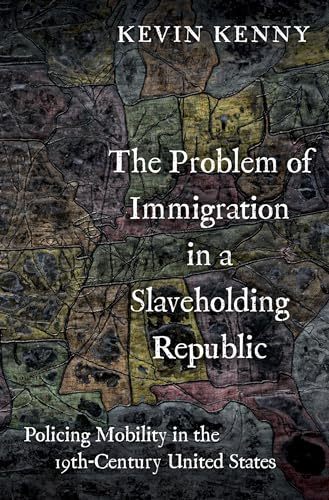
The Problem of Immigration in a Slaveholding Republic: Policing Mobility in the Nineteenth-Century United States
In The Problem of Immigration, readers are introduced to a familiar historical struggle between the states and the federal government regarding matters of constitutional interpretation. Slave states in the antebellum period perceived a government overstepping its authority as it grew increasingly hostile to slavery. While Kevin Kenny presents the fear of the South losing control over slavery and the movement of free Black populations, he does so through the lens of several states’ police power over immigration.
Continue reading...
32 notes
·
View notes
Text
"A Union Is As Strong As The Workers In It"

This poster is one example of many in the Guide to the Kheel Center Poster Collection, #6227, that includes posters advocating for health and safety policy reform, human rights issues, discrimination, political campaigns, labor issues, and unionization. The poster above is an example of publicity used to boost unionism and the strength of unions.
See Collection #6227 for more posters.
#KheelCenter#Unions#Strikes#Contract#Posters#LaborHistory#Cornell#CornellILR#LaborRights#ArchivesHistory#LaborInTheArchives#LaborArchives
18 notes
·
View notes
Text

Happy World Chocolate Day?
Well, not if you're one of the >1.6 million kids slaving away in West Africa (or Brazil or Latin America) for up to 14 hours/day, sometimes literally as slaves, under dangerous conditions, to produce the majority of the chocolate sold by the major candy companies, including Mars Wrigley, Ferrero, Mondelez International, Meiji Co. Ltd., Nestle and Hershey Co.
In 2021, SCOTUS ruled 8-1 that Big Chocolate had no responsibility to ensure that their products were not produced by child laborers.
#WorkingClass#LaborHistory#ChildLabor#chocolate#SCOTUS#slavery#WestAfrica#ghana#IvoryCoast#ausgov#politas#auspol#tasgov#taspol#australia#neoliberal capitalism#anthony albanese#fuck neoliberals#albanese government
18 notes
·
View notes
Text
youtube
Labor Day
#HYWIN#LaborDay#WorkersRights#LaborUnions#Workforce#LaborDayWeekend#HardWorkPaysOff#CelebrateLabor#LaborHistory#LaborDayParade#LaborDaySale#AmericanWorkers#LaborDay2023#HonoringLabor#LaborMovement#UnionStrong#LaborRights#LaborDayParty#LaborDayBBQ#LaborDayFun#WorkHardPlayHard#LaborDayOff#LaborDayWeek#LaborDayPicnic#LaborDayTradition#LaborDayCelebration#LaborDayCookout#LaborDayFamily#LaborDayFestivities#LaborDayGathering
0 notes
Text

Post: Is There More Overtime Pay In Your Future? What You Need To Know About A New Biden Proposal https://www.blaqsbi.com/5jpK
0 notes
Photo

A bill now seeks to give Kenyans the 'right to disconnect' after work
A new bill is being proposed through Kenya’s senate to block employers from interfering with the work-life balance of their employees through calls, text messages, emails, or assignments past working hours, weekends, and public holidays.Read more...
https://qz.com/the-right-to-disconnect-after-work-is-coming-to-kenya-1850032205
#righttodisconnect#humanactivities#laborhistory#workingconditions#kenya#worke28093lifebalance#susangituku#nandi#samsoncherarkey#workingtime#jacqueline#labourlaw#labor#overtime#Faustine Ngila#Quartz
0 notes
Text
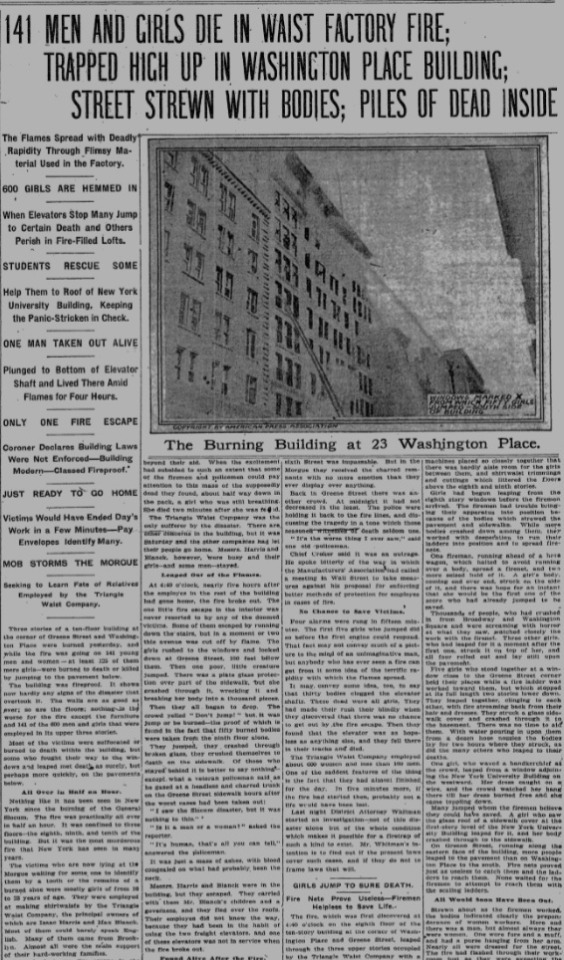
On This Day in New York City History March 25, 1911: A deadly fire erupted in the Asch Building located on 23-29 Washington Place which led to the deaths of 146 people (123 women and 23 men.)
The Triangle Shirtwaist Factory occupied the 8th, 9th and 10th floors of the Ashe Building. Blocked stairwells and locked exits hindered the attempts for those trapped by the blaze to be rescued and to escape. The only fire escape collapsed due to the weight of those trying to escape the fire. The Fire Department was also hampered by having ladders that reached up to the 6th floor. Many leapt to the deaths trying to escape the flames.
The Sullivan-Hoey Fire Prevention Law was signed in October 1911, which required sprinkler systems to be installed in buildings. The Factory Investigative Committee was also formed whose observations led to 20+ new laws being passed in the areas of building, fire amd workers safety.
With the overwhelming majority of those killed being immigrant women who often worked grueling 50+ hour, six day work weeks, the International Ladies' Garment Workers' Union (ILGWU) saw a rise in both membership and prominence.
While tragic, many of the lessons from that day were learned and applied in safer environments for workers today.
#TriangleShirtwaistFactoryFire #AschBuilding #LaborHistory #SafetyHistory #WomensHistory #WomensStudies #HERStory #NewYorkHistory #NYHistory #NYCHistory #History #Historia #Histoire #Geschichte #HistorySisco
#Triangle Shirtwaist Factory Fire#Asch Building#Labor History#Safety History#Fire Safety#Women's History#Women's Studies#HERStory#New York History#NY History#NYC History#History#Historia#Histoire#Geschichte#HistorySisco
33 notes
·
View notes
Photo




Images of the front and back of union advocacy postcards found in the Labor sub series of the LOUIS J. TWOMEY, S.J., PAPERS correspondence, 1954. #unions #laborrights #socialjustice #archives #laborhistory https://www.instagram.com/p/CbfkbwKrPX5/?utm_medium=tumblr
11 notes
·
View notes
Text
The Pittsburgh Musicians’ Union Merger: “It Revolves Around Representation”
This post was written by Char Pyle (Fall 2021 Undergraduate Intern).


(Above) Pages from the program of the AFM’s 1962 Annual Convention, hosted at the Civic Arena in Pittsburgh. American Federation of Musicians, Local 60-471, Pittsburgh, Pa. Records, 1906-1996, AIS.1997.41, Archives & Special Collections, University of Pittsburgh Library System.
The American Federation of Musicians (AFM) is a labor union representing musicians across the country. The Pittsburgh Musicians’ Union, Local 60-471 of the AFM, has a particularly storied history. Local 60 was formed in 1897, one year after the AFM was founded. In 1908, Local 471 was created for black musicians in Pittsburgh. The two locals merged in 1966 following an integration order from the AFM. While the integration seems like it could be a positive thing, this only meant it would be more difficult for black musicians to advocate for themselves and be heard. This is evident even in the meeting minutes between both locals surrounding the merger. This interaction is noted at the beginning of the meeting:
“Before considering items, Pres. Davis asks: ‘How can we meet on common ground? What do we need? (to effect agreeable merger)’ Pres. Westray answers: ‘It revolves around representation.’”
This emphasis on representation is visible in Local 471’s proposals during the merger. Policies proposed by Local 471 included suggestions of affirmative action, shown in “Exhibit D” under “Negro Representation in Elective Offices of the Merged Union”. They sought out guaranteed representation in elected office, as they were likely not hopeful that they would truly be perceived as equals by the majority-white membership base of the merged union. Unfortunately, this has proved to be true. Since the merger, and still today, leadership of Local 60-471 is primarily white. Based on these minutes, it appears these suggestions were heavily contested and subsequently dismissed by members of Local 60. One of their arguments was that this was “a type of segregation in reverse”. This shouldn’t be an unfamiliar idea, as similar arguments are still echoed today in the realms of employment and education.

(Above) Exhibit D in the merger meeting minutes between the executive boards of both locals. American Federation of Musicians, Local 60-471, Pittsburgh, Pa. Records, 1906-1996, AIS.1997.41, Archives & Special Collections, University of Pittsburgh Library System.
Another result of the merger is the lack of records from Local 471. There is significantly more material available for Local 60, including film reels, publications, meeting minutes, photographs, and various booklets. It’s not clear why this discrepancy exists, but Local 471’s records may have simply been overshadowed as the merged union was mostly made up of former Local 60 members. This could have led to the merged local being viewed as simply a continuation of the white local, devaluing the preservation of artifacts related to Local 471. The merger also caused many black members to become disillusioned with the union, so there wouldn’t have been many people interested in preserving those records anyway. The effects of this lack of preservation were apparent almost immediately, as membership cards for many Local 471 members were lost in the merger. This led to a discontinuation of seniority benefits (even though the opposite was promised in the merger minutes), which caused many to cancel their memberships.
It’s difficult to say whether much would have changed had these policies been approved. Perhaps with more of a presence in the administration of the union, Local 471 would have retained more of its membership and its history would have been better preserved. When so many former Local 471 members resigned, they lost the ability to play music in Pittsburgh. The city may have missed out on countless performances and talented artists because of this. Unfortunate as it may be, this event was a milestone for black musicians in Pittsburgh, and greatly shaped the landscape of Pittsburgh music as a whole. This collection would be of use to those researching local musicians from the 20th century. Prominent figures that were members of Local 471 include the following, and membership cards are available for each:
Carl Arter (President)
George Benson
Art Blakey
Ray Brown
Roy Eldridge
Erroll and Linton Garner
Walter Harper
Joe Harris
Earl Hines
Roger Humphries
Ahmad Jamal
Grover Mitchell
Horace Parlan
Stanley Turrentine
Joe Westray (President at time of merger)
Mary Lou Williams
Ruby Younge Hardy (Secretary-Treasurer)
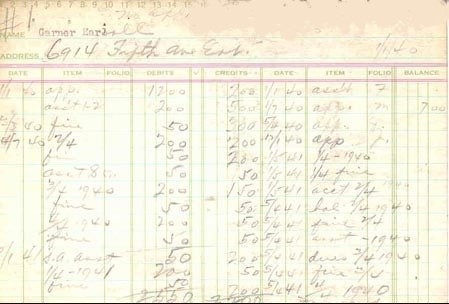

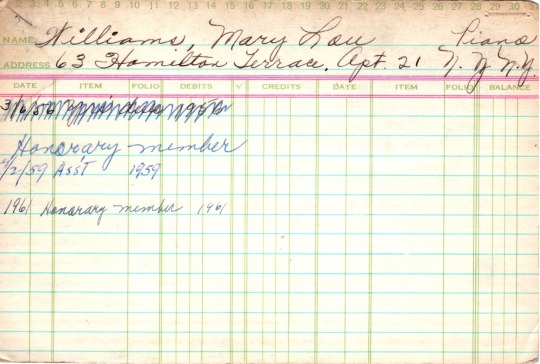
(Above) Membership cards (from top to bottom) of Art Blakey, Erroll Garner, and Mary Lou Williams. American Federation of Musicians, Local 60-471, Pittsburgh, Pa. Records, 1906-1996, AIS.1997.41, Archives & Special Collections, University of Pittsburgh Library System.
Additional Sources:
http://jazzburgher.ning.com/profiles/blogs/old-mon-music-pittsburgh-blog
https://www.afm.org/about/history/
https://www.afmpittsburgh.com/a01-aboutus.html
http://exhibit.library.pitt.edu/labor_legacy/MusiciansHistory471.htm
American Federation of Musicians, Local 60-471, Pittsburgh, Pa. Records, 1906-1996, AIS.1997.41, Archives & Special Collections, University of Pittsburgh Library System
2 notes
·
View notes
Photo
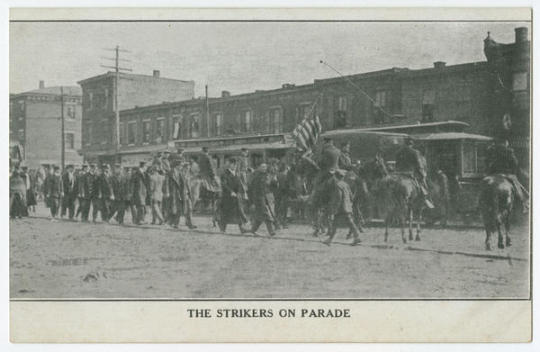
Happy Labor Day! This postcard documents a 1908 trolley strike in Chester, Pennsylvania. In response to falling revenue, the Chester Traction Company slashed pay rates. This decrease in pay prompted the Amalgamated Association of Street Railway Employees to shut down public trolleys from Philadelphia to Wilmington.
Trolley Strike postcard (Philadelphia: Keystone Post Card Company, ca. 1910). Photolithograph. From the Brightbill Postcard Collection.
#LCPprints#BensLibrary#librariesofinstagram#iglibraries#SpecialCollections#MuseumfromHome#LaborDay#laborhistory
8 notes
·
View notes
Text
The 108th Anniversary
Today is the 108th anniversary of the Triangle Shirtwaist Fire. On March 25th, 1911, 146 people, mostly young Jewish and Italian immigrant women lost their "American Dream" and died in the course of eighteen horrible minutes. Remember them when tempted to forgo constitutional norms in favor of political exigencies. Remember them when tempted to deny a century of social reform in the pursuit of Golden idols. We must never forget them.
(C) DE Wolf 2019
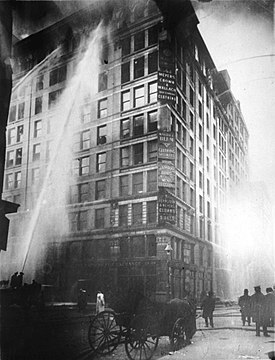
2 notes
·
View notes
Photo

Reposted from @laborintheschools Support @bctgm and all striking workers! #workersstrike #bctgm #supportstrikingworkers #dontcrossthepicketline #boycottkelloggs #unions #laborunions #labormovement #tradeunions #organizedlabor #1u #workers #work #solidarity #workersrights #humanrights #history #laborhistory #teachers #teaching #education #teachlaborhistory #laborhistoryisyourhistory #aflcio #cft #lcje #laborintheschools #adventist #battlecreek #michigan https://www.instagram.com/tephlon_don3/p/CXl-Nm8Fvv2/?utm_medium=tumblr
#workersstrike#bctgm#supportstrikingworkers#dontcrossthepicketline#boycottkelloggs#unions#laborunions#labormovement#tradeunions#organizedlabor#1u#workers#work#solidarity#workersrights#humanrights#history#laborhistory#teachers#teaching#education#teachlaborhistory#laborhistoryisyourhistory#aflcio#cft#lcje#laborintheschools#adventist#battlecreek#michigan
0 notes
Text
Found in the Archives Friday
Today’s Found In The Archives is a 1978 exposé on union-busting tactics written by an undercover @1199seiu reporter!

Check out the Kheel Center’s guide to other anti-union campaign materials here:
This item was found during a year-long survey that the Kheel Center is conducting to better document and describe their collections.
#LaborHistory#KheelCenter#FoundInTheArchives#ILR#CornellUniversity#Cornell#LaborArchives#2024#ArchivesOfTumblr#ILRSchool
11 notes
·
View notes
Text

The Working Class and the employing class have nothing in common.
There can be no peace so long as hunger and want are found among millions of the working people and the few, who make up the employing class, have all the good things of life.
Between these two classes a struggle must go on until the workers of the world organise as a class, take possession of the means of production, abolish the wage system, and live in harmony with the earth.
#Workingclass #LaborHistory #IWW #ClassWar #WageSlavery
#workers rights#working class#labor history#iww#iwa#asf#class war#wage slavery#ausgov#politas#auspol#tasgov#taspol#neoliberal capitalism#australia#fuck neoliberals#anthony albanese#albanese government#class warfare#classism#classwar#humanrights#chattel slavery#slaves#slavery#slave#antifa#antifascist#antiauthoritarian#antinazi
92 notes
·
View notes
Photo

Amitav Ghosh’s 2008 novel Sea of Poppies has long been my comfort book. So it only makes sense that it will be my first book recommendation. Set partly in Colonial Bihar and Bengal, and partly in the waters of the Bay of Bengal and the Indian Ocean, Sea of Poppies opens in 1838, on the eve of the Opium Wars. A former slave ship called the Ibis has been refurbished to transport indentured labourers from Calcutta to the sugar plantations of Mauritius; the story follows the lives of its crew and passengers as they find their way on board the Ibis. More often than not, nationalist history writing paints the history of indenture as a history of lost identities and homelands. In such broad ideological generalizations, the personal histories of individual experiences are often neglected and undermined. What I love about this novel is that it attempts to imagine the “lost” histories of these people through fiction. Fiction is obviously not a placeholder for history. Nor does a novel fill the gaps in the archives. What it does, however, is that it humanizes the names and numbers that appear in the maritime and immigration records of the colonial archive, bringing to life those who remain otherwise separated by so much time that they inhabit a very different world from our own. #bookstagram #bookrecommendations #booklover #igbooks #indianliterature #indianenglish #indianhistory #diaspora #southasianart #southasianliterature #southasianhistory #asianhistory #amitavghosh #seaofpoppies #indenturedlabourers #indenture #migration #postcolonialliterature #worldliterature #laborhistory #britishcolonial #colonialhistory #historicalfiction #colonialindia #calcutta #mauritius https://www.instagram.com/p/CP99GMMly8J/?utm_medium=tumblr
#bookstagram#bookrecommendations#booklover#igbooks#indianliterature#indianenglish#indianhistory#diaspora#southasianart#southasianliterature#southasianhistory#asianhistory#amitavghosh#seaofpoppies#indenturedlabourers#indenture#migration#postcolonialliterature#worldliterature#laborhistory#britishcolonial#colonialhistory#historicalfiction#colonialindia#calcutta#mauritius
0 notes
Photo
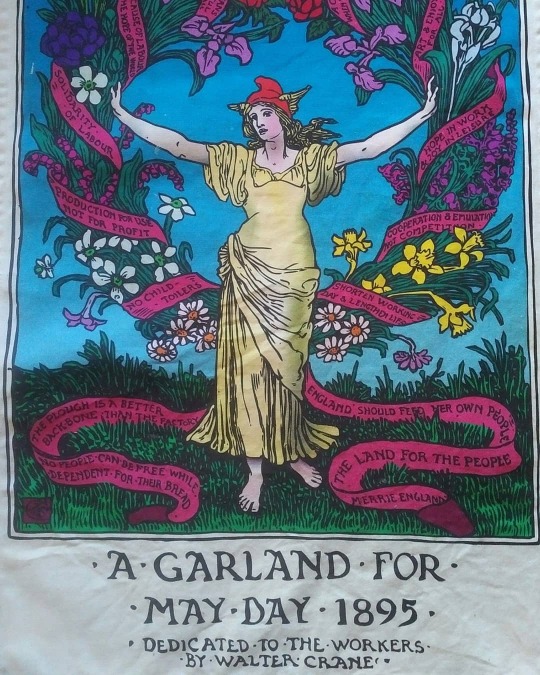
Happy #MayDay! This beautiful 1895 Art Nouveau illustration by Walter Crane inspired several of my artistic and plot choices in DEAD RINGER, forthcoming from @RealmMedia, edited by the amazing @diana.m.pho! My new series stars working-class amateur sleuths, a hot Immigration and civil rights lawyer, a beautiful friendly ghost and a bunch of labor activists in 1892 NYC. Thank your local labor unions today for any and all rights you have in your workplaces! The fight is still ongoing! -- #authorsofinstagram #writersofinstagram #inspiration #laborhistory #workersoftheworldunite #unionproud #newbooks #upcomingbooks #podcasts #amwriting #amediting #nychistory https://www.instagram.com/p/COWOuAQjJcZ/?igshid=1jyazbyyz78q2
#mayday#authorsofinstagram#writersofinstagram#inspiration#laborhistory#workersoftheworldunite#unionproud#newbooks#upcomingbooks#podcasts#amwriting#amediting#nychistory
0 notes